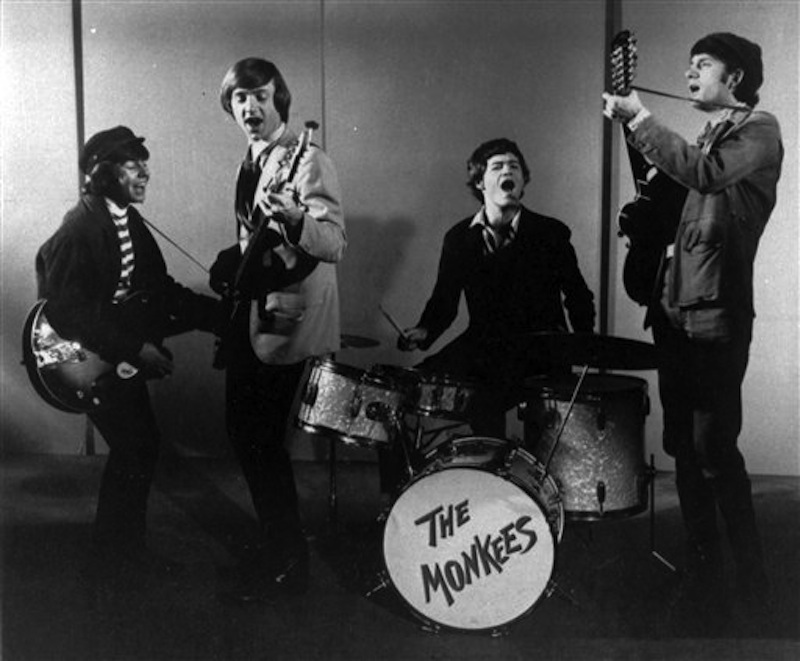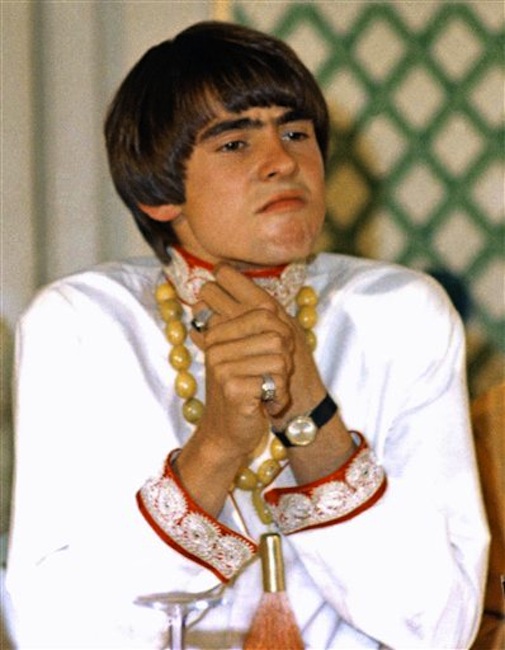LOS ANGELES — Before there was MTV, before “American Idol” made overnight stars of people you never heard of, there was “The Monkees,” a band fronted by a diminutive singer named Davy Jones who was so boyishly good looking that teenage girls swooned the first time they ever saw him.
That was at the end of the summer of 1966, when Jones and his three Monkee cohorts, Michael Nesmith, Peter Tork and Micky Dolenz, arrived on weekly television, portraying a carbon copy of another band called the Beatles.
Each Monday night for the next two years, people would tune into NBC to see the comical trials and tribulations of four young musicians who tooled around in a tricked-out car called the Monkeemobile. When they weren’t introducing two or three new songs per show, they would be busy rescuing damsels in distress or being chased by bumbling outlaws in a comical display of slapstick that has sometimes been compared to the work of the Marx Brothers.
Although all four members handled the lead vocals during their music videos, it was Jones, the onetime child star of the British musical stage, who quickly became the group’s heartthrob. With his boyish good looks and endearing British accent augmented by a strong, Broadway-trained singing voice, it was a role he would play for the rest of his life.
Jones died Wednesday of a heart attack near his home in Indiantown, Fla., just months after he, Tork and Dolenz had completed a tour marking The Monkees’ 45th anniversary. He was 66.
The Monkees had been created to cash in on the Beatles’ popularity, and although they never came close to achieving the critical stature of their counterparts, they did carve out a permanent niche in music as what Rolling Stone’s Encyclopedia of Rock ‘n’ Roll has called “the first and perhaps the best of the ’60s and ’70s prefabricated pop groups.”
Their songs were melodic, catchy, and many have endured over the years. The first two they released, “Last Train to Clarksville” and “I’m a Believer,” became No. 1 hits. So did “Daydream Believer,” on which Jones sang the lead and which Dolenz told The Associated Press four years ago remains the Monkees’ most requested song at concerts.
“Of the four actors they hired, Davy Jones was by far the most accomplished as a singer and as a performer. He was really the perfect choice,” said Rich Podolsky, author of a biography of Don Kirshner, who was “The Monkees” TV show’s musical director.
Born in Manchester, England, on Dec. 30, 1945, Jones had been a child star in his native country, appearing on television and stage, including a heralded role as “The Artful Dodger” in a London production of the play “Oliver.”
When the show came to Broadway, he earned a Tony nomination at age 16 for the role, a success that brought him to the attention of Columbia Pictures/Screen Gems Television, which created “The Monkees.”
Hundreds of musician-actors turned out for the auditions, but the young men who became the Monkees had no idea what ultimately awaited them.
“They had an ad in the newspaper,” Jones recalled on NBC’s “Today Show” last year, “and then we all showed up.”
When they put him together with Tork, Dolenz and Nesmith, the chemistry was obvious.
“That’s it,” he recalled everyone around him saying: “Magic.”
At 5-feet-3 inches, he was by far the shortest member of the group — a fact often made light of on the show. But he also was its dreamboat, mirroring Paul McCartney’s role in the Beatles. And as the only Briton among the four, Jones was in some ways the Monkees’ direct connection to the Beatlemania still strong in the U.S. when the TV show made its debut.
In August 1966, the Beatles performed in San Francisco, playing their last live set for a paying audience. The same month, the Monkees released their first album, introducing the group to the world. The show would debut the following month.
It was a shrewd case of cross-platform promotion. As David Bianculli noted in his “Dictionary of Teleliteracy,” ”The show’s self-contained music videos, clear forerunners of MTV, propelled the group’s first seven singles to enviable positions of the pop charts: three number ones, two number twos, two number threes.”
The Monkees would soon come under fire from music critics, however, when it was learned that session musicians — and not the group’s members — had played the instruments on their recordings. They were derided as the “Prefab Four,” an insulting comparison to the Beatles’ nickname, the “Fab Four.”
In reality, Jones could play the drums and guitar. Although Dolenz, the group’s drummer on the show, only learned to play that instrument after he joined the Monkees, he also could play guitar.
Nesmith played guitar and wrote numerous songs, both for the Monkees and others. Tork, who played bass and keyboards on the TV show, was a multi-instrumentalist.
The group eventually prevailed over the show’s producers, including Kirshner, and began to play their own instruments. Regardless, they were supported by enviable talent.
Carole King and Gerry Goffin wrote “Pleasant Valley Sunday,” and Neil Diamond penned “I’m a Believer.” Musicians who played on their records included Billy Preston, who later played with the Beatles, Glen Campbell, Leon Russell and Ry Cooder.
If the critics didn’t initially like them, the group’s members had admirers among their fellow musicians.
“The Monkees were such a sensation that it was a thrill for me to have them record some of my early songs,” Neil Young tweeted Wednesday.
Frank Zappa even appeared on an episode of the show, disguised as Nesmith for a bit in which he pretended to interview Nesmith, who was disguised as Zappa.
Jimi Hendrix opened for the group during part of its 1967 concert tour. He left early, however, in part because fans kept chanting Jones’ name during his sets.
Eventually, even the critics would come around, with Rolling Stone’s rock encyclopedia acknowledging that the Monkees made “some exceptionally good pop records.”
After the TV show ended, Jones continued to tour with the group for a time, sometimes playing the drums at concerts when Dolenz came up front to sing.
“He was one of the funniest men and most talented I have ever known,” Tork said in an interview Wednesday night.
Although the group would eventually break up over creative differences, it would reunite periodically over the years for brief tours, usually without Nesmith.
In 1987, Jones, Tork, and Dolenz reformed to record the album, “Pool It,” and in 1996 all four of the Monkees got back together for the album “Justus” and a TV movie “Hey, Hey, It’s The Monkees!” The film, directed by Nesmith, featured them once again tooling around in the Monkeemobile.
“David’s spirit and soul live well in my heart, among all the lovely people,” Nesmith said in a statement Wednesday.
For “Justus,” the quartet’s last recording, the four made a point of playing every instrument themselves, in part to prove that they could.
Although the Monkees received a star on the Hollywood Walk of Fame in 1989, one honor that has eluded the group was induction into the Rock and Roll Hall of Fame. For years, supporters have circulated petitions demanding that the group be included.
Jones, meanwhile, continued to perform, both with and without the Monkees. In recent years, he appeared from time to time on television and stage, as well as in concert with a band of his own.
It was on the stage, he said, that he truly felt comfortable.
“Even today, I have an inferiority complex,” he told the Daily Mail in an interview last year. “I always feel I’m there at the window, looking in. Except when I’m on stage, and then I really come alive.”
He is survived by his wife, Jessica Pacheco, and four daughters from previous marriages.
Send questions/comments to the editors.



